Vol 2 No. 31 TROPIC LIGHTNING NEWS Aug 7, 1967
Index
Ralliers
Continue Despite VC Terrorism
Despite Viet Cong threats to
cut off their noses and ears, local Viet Cong in Hau Nghia Province are rallying
to the Government side in record numbers for the second month in a row.
For the first time since the
arrival of 25th Inf Div soldiers in the area nearly 20 months ago, many VC are
turning themselves in to U.S. units.
One hundred and thirty-three
former Viet Cong have come in to “Chieu Hoi” or Open Arms centers in the
Province in the first three weeks of July.
Sixteen surrendered to men of the 1st Bn, 27th Inf “Wolfhounds,”
during one four day period.
“Threats of personal
violence and harm to families have prevented many of them from coming in
before,” said MAJ Lynn Steverson, 2nd Bde intelligence officer from Bonifay,
Fla, “Now they see that we plan to stay in the area and can protect them.”
Most of the returnees are
local guerrillas and farmers. “Many
of them are more important to us than VC soldiers.” said Steverson, “They
are the ones who provide hard core units with food, guides and intelligence.
“In the past they have
been reluctant to turn themselves over to American units,” he explained,
“but now after months of operations in the area and intensive psychological
operations, they are beginning to see that we mean just what we say and can
prevent VC retaliation.”
Most of the Bde’s
psychological operations during its monsoon season Operation “Kolekole” have
been tailored to current actions rather than using standardized material.
 |
HEAVEN SENT - Seemingly standing in the clouds, SSG Romolo Oliva of New York City, is actually giving landing directions by radio and smoke to cargo helicopters bringing in artillery to a 25th Inf Div forward fire support base, 37 kms northwest of Saigon. Oliva, assigned to the 11th Avn Bn as a pathfinder, is the first man into a landing zone to guide incoming choppers carrying troops and supplies. (Photo by Lt. A. R. Karel) |
Massive
Camp Found
A critical Viet Cong
stronghold, unchallenged by allied forces for six months, is again the focal
point for combat operations by elements of the 25th Inf Div’s 2nd Bde.
The 1st Bn (Mech),
5th Inf. recently pushed their way into the heavy monsoon growth of
the Loc Giang area, 25 kms west of the Div’s Cu Chi base camp and established
the mechanized Fire Support Patrol Base Foss.
The base is the center for
search and destroy operations in what brigade officers call one of the most
critical areas of Viet Cong operations in the unit’s entire area of
responsibility. Foss lies astride
one of the major enemy infiltration routes from the Cambodian border to the Hau
Nghia Province-Saigon area.
The Loc Giang sector is
bordered by the wide Oriental River. Hundreds
of small streams and canals lace the area with several major canals to the west.
These streams and canals
were the sight of major finds by the battalion which included a large mortar
ammunition storage position and a suspected Viet Cong grenade factory.
Here grenade molds, powder, sizing material and metalworking tools were
uncovered by the unit’s Co A.
Massive Camp
Near the factory, across the
Oriental from a major canal leading to the Cambodian border, the mechanized unit
uncovered a massive base camp. “We
estimate,” said Battalion Commander LTC Chandler Goodnow, “that this camp
could easily support 600 to 700 enemy soldiers.
It could serve as a staging area for major attacks on any part of Hau
Nghia Province.”
At the camp site 84 large
living bunkers were found and destroyed. Several
hundred dishes and eating utensils were also destroyed.
In their first week at Foss,
the track-mounted soldiers have destroyed 349 bunkers, 249 booby-traps, 54
tunnels and 88 camouflaged spider holes.
Before moving to Foss, the
battalion operated out of the massive forward base Nickel, five kms east of the
Province capital at Bao Trai.
‘Birddog’
And Crew Lifted Out
DUC
PHO -
Barely 20 minutes after their forced landing, the two-man crew of an Army O-1,
fixed-wing observer plane was scooped up by a rescue helicopter and the airplane
secured by ground forces.
SFC John C. Stamper, the 3rd
Bde, 25th Inf Div’s chief intelligence NCO, and the aircraft’s pilot, LT
Duncan, had taken off early in the morning on an aerial recon mission along the
coast of the South China Sea north of Due Pho.
Duncan was awaiting the
completion of an air strike so he could return and Stamper could assess the
damage when suddenly the O-1 “Birddog” suddenly developed engine trouble.
“It wasn’t more than two
minutes after he notified me of the trouble that we had to make a forced landing
on the beach,” said Stamper.
“Before we were forced to
land we notified the ground troops of our situation and approximate location.
After setting down we didn’t have to wait long as a chopper arrived
quickly to lift us out,” the intelligence sergeant added.
Infantrymen from the 2/35th
and tracks from the 2/34th Armor arrived within 20 minutes to protect the
aircraft.
Trophy
Warning
SAIGON
- San Francisco customs inspectors have reported many items of explosive
ordnance in parcels mailed through Vietnam APOs.
These items have included CX plastic explosives, claymore mines with
arming mechanisms, TNT, rifle grenades, flares and M-72 rockets with launchers.
Authorized war trophies
which are not firearms may be mailed if acceptable in accordance with the Postal
Manual.
Customs declarations must
show complete and accurate descriptions of contents of packages and
parcels.
MACV officials announced that all cases of violation will be
referred to appropriate criminal investigation agencies for investigation and
positive disciplinary action will be taken in appropriate cases.
Chaplain’s
Perseverance Pays Off
By
2LT W.A. Falks Jr.
Months of hard work and
perseverance by a U.S. Army Chaplain assigned to the 25th Inf Div’s 1st Bde
has led the way for one of the largest and most comprehensive civic action
projects yet undertaken by the division.
The village of Phu Hoa Dong,
located at the edge of the notorious Filhol Plantation, 37 kms northwest of
Saigon, has long been a haven for the Viet Cong operating in that area as well
as a suspected vital link in the VC’s supply line into Saigon.
Its population of approximately 10,000 is suspected to be 80 per cent VC
or VC sympathizers.
A plan was formulated to
deny the local Viet Cong the use of the village.
The operation began July 8 as the three infantry battalions assigned to
the 1st Bde, in conjunction with three ARVN infantry battalions, sealed the
village and permitted no traffic in or out of it. Registration of the inhabitants and an intensive
house-to-house search followed.
Then it was the turn of the
Civil Affairs teams. Extensive
Medical Civic Action Programs (MEDCAP) were held to treat the sick and injured
in the village. Schools were
surveyed to determine what equipment they needed most and all other areas
pertaining to the health and welfare of the villagers were examined to decide
how the government could best help the village.
Several months prior to the
operation Chaplain (Maj) James A. Peterman of Wilmington, Del., learned that Phu
Hoa Dong had a church with no priest. Working
with his assistant, SP4 Joseph R. Zapata of Brooklyn, Father Anthony Tran Van
Phau, a Catholic priest from Cu Chi, and SSG Nguyen Taun, a Vietnamese
interpreter, Father Peterman began making regular visits to Phu Hoa Dong.
At first only a few of the
Catholic villagers attended confession and masses.
Peterman, however, persisted until he finally gained the confidence and
respect of the villagers. He came
unarmed and without security to the heavily-infested Viet Cong area.
Despite adversities and danger he brought the word of God rather than the
weapons of war.
It was always risky. Once,
the day before their weekly visit, the VC mortared the hamlet causing deaths,
injuries and severe damage. On
another occasion Chaplain Peterman and his associates were waiting to be picked
up by a helicopter when they were hit by mortar and small arms fire.
No one was injured but they were delayed two hours.
Father Peterman celebrated
the first day of the operation by performing 25 baptisms and six marriages.
Page 2 TROPIC LIGHTNING NEWS Aug 7, 1967
Decorated
Let
every nation know, whether it wishes us well or ill, that we shall pay any
price,
bear any burden, meet any hardship, support any friend, oppose any foe, to
assure
the survival and success of
liberty.
John F. Kennedy
| SILVER STAR | |
|
LT Charles L. Johnson, B Trp, 3d Sqdn, 4th Cav |
SSG Ronald A. Payne, Co A, 1st Bn (Mech), 5th Inf |
DISTINGUISHED FLYING CROSS |
|
|
BG
Robert C. Shaw, HHC |
LT
Charles J. Slimowicz, Co A, 25th Avn Bn LT Gerald L. Wright, D. Trp, 3d Sqdn, 4th Cav W01 John D. Heath, Co B, 25th Avn Bn W01 Waverly P. Jones, 173d Aslt Hel Co W01 Fred E. Startz, HHC, 196th Lt Inf Bde CPL Dennis H. Shappell, 173d Aslt Hel Co |
BRONZE STAR (VALOR) |
|
|
LTC
John R. Thurman III, HQ, 1st Bn, 8th Arty |
SP5
James B. Hamblen, HQ & Svc Btry, 2d Bn, 77th Arty |
BRONZE STAR |
|
|
MAJ
Walter T. Brown Jr., Hq, 725th Maint. Bn. |
1LT
Raymond A. Szzrek, HHC, 4th Bn (Mech), 23d Inf SGM Clifton D. White, Hq, 725th Maint Bn SGM James Vaughan, HHC & Band, 25th Inf Div SSG Robert F. Haines, HHC, 4th Bn (Mech), 23d Inf SSG Lowell C. London, Hq & Co A, 25th Med Bn |
Know
Your Enemy
Organized Red Terror
Nguyen Van Tram was a
village chief in Kien Phong Province. The
Viet Cong kidnapped him and made him pay a ransom of 42,000 piasters.
Afterward they chopped off one of his fingers to remind him that they,
the Viet Cong, were to be feared and obeyed.
Mr. Tram was comparatively
fortunate. One evening the Viet
Cong entered the house of Huynh Huu Be, chief of Phong Dinh Village.
They dragged him into the courtyard of his home with the obvious
intention of murdering him. His wife, who had been bathing their six-year-old daughter,
ran out of the house and threw herself in front of her husband.
The Viet Cong shot her. Then
they shot her husband.
Meanwhile, their terrified
daughter ran out of the back door to hide in the garden. A Viet Cong guerrilla spotted the child and riddled her naked
body with bullets from a submachine gun. The
murder had been coldly planned two weeks earlier and was carried out calmly -
without emotion.
Strike
Anywhere
Highly motivated, willing to
take great risks, operating in either urban or rural areas they know well,
members of these cells are able to strike virtually anywhere, at any time.
From the rosters of these cells are drawn the assassination teams, the
volunteer grenade hurlers and the killer or suicide squads.
Most of the spectacular acts of terror, sabotage, and assassinations
throughout Vietnam are the work of these cells.
Although highly motivated and possessing good knowledge of local terrain,
these cell members usually lack technical skills, such as the ability to
manufacture and detonate explosive devices.
Those technical skills, and sometimes leadership, is supplied by the
Provincial or Zone Headquarters of the National Liberation Front.
Not
Yielding
However, the Vietnamese
people are becoming less afraid of these terrorists and are resisting more and
more. They are not yielding to the
pressure of the terrorists as they once did.
The communist grasp is
weakening
New
Pass Hours
A new regulation setting
forth requirements for soldiers desiring to become aerial door gunners has been
published by Hqs, 25th Inf Div.
Regulation Number 614-200
sets the following criteria:
EM must be in grade SP4 or
below; be assigned to an infantry, cavalry, or mechanized unit within the
division for at least four months; have an MOS of 11B, 11C, 11D, 11E, 11F, or
11H; have at least four months retainability; pass a flight physical; and be
accepted through interview by the gaining organization.
Interested personnel should
see their 1SG for proper application procedures.
| Pass time limits to Cu Chi and Bac Ha given in last week’s TLN were changed after the paper went to press. New time limits are 45 minutes for Administrative passes and two hours for Regular passes. Personnel are reminded that the “two per vehicle” rule is still force, and that individuals in vehicles on Admin pass cannot give rides to persons on Regular pass. |
We,
too, born to freedom, are willing to fight to maintain freedom.
We, and all others who believe as deeply as we do, would rather die on
our feet than live on our knees.
Franklin D. Roosevelt
CODE
OF CONDUCT NO. 1
I am
an American fighting man. I serve
in the forces which guard my country and our way of life.
I am prepared to give my life in their defense.
The TROPIC LIGHTNING NEWS is an authorized publication of the 25th Infantry Division. It is published weekly for all division units in the Republic of Vietnam by the Information Office, 25th Infantry Division, APO San Francisco 96225. Army News Features, Army Photo Features, Armed Forces Press Service and Armed Forces News Bureau material are used. Views and opinions expressed are not necessarily those of the Department of the Army. Printed in Tokyo, Japan, by Pacific Stars and Stripes.
Maj.Gen. John C. F. Tillson III . . . . Commanding General
Maj. Bernard S. Rhees . . . . . . . . . . . Information Officer
1Lt. Larry Rottmann . . . . . . . . . . . . . Officer-in-Charge
SSgt. David G. Wilkinson . . . . . . . . Editor-in-Chief
Sp5 Terry S. Richard . . . . . . . . . . . . Editorial Assistant
Pfc Dave Cushman . . . . . . . . . . . . . Editorial Assistant
Page 3 TROPIC LIGHTNING NEWS Aug 7, 1967
Continued
Education Offered at Ed Center
By PFC George
Hairston
You can receive a formal
education in Cu Chi. The 25th Div
Education Center located behind the Ilikai East Service Club offers high school
equivalency tests, preparation for these tests, and USAFI college correspondence
courses.
There are two forms of
college correspondence courses. The
USAFI (US Armed Forces Institute) program costs $5 for the first course.
Upon successful completion of this college level course, the student is
encouraged to take as many as two courses at a time free of charge as long as he
passes the courses. This instruction covers general college subjects of the first
two years of college. Many USAFI
courses are immediately available at the center, others can be ordered.
Upon Application for residence instruction at a college or university,
these USAFI courses may be transmitted to college credit.
The contract college courses
are taken directly from the college of your choice upon completion of their
entrance requirements. The
government pays the tuition for the correspondence course and the student pays
the entrance fee and the cost of the books used.
The fee ranges from $15 to $30 per course depending upon the school and
the texts used.
The high school equivalency
program is one of the most important aspects of the Education Center.
The program awards a student a high school diploma.
The diploma is awarded after successful completion of the GED (General
Educational Development) test. Having
met these requirements, the high school equivalency certificate.
When approved, he then has civilian accreditation for high school.
When a soldier applies for
the equivalency test, he is given an achievement test by SP4 Lloyd Veen, the
NCOIC of the center or SP4 Ray O’Conner, the test monitor. The results of the test show the areas in which the student
has difficulties. He is then
tutored in these areas.
Classes are held six nights
a week, from 7:00 to 10:00 every night except Saturday. SP4 O’Conner teaches English, MAJ Richard Tallon, the XO of
the 554th Engr Bn, teaches math and Air Force 1LT Dennis H. Quine teaches
science. PFC Neal Jussila, a combat
artist, teaches social studies. These
classes are designed to prepare the student for the equivalency tests.
This tutoring program is under the direction of the division education
officer, 1LT Ransom Cooper Jr.
At present there are nearly
500 men actively enrolled in the various phases at the center.
These are people like a soldier from the 65th Engr Bn with a third grade
education who is being tutored for the high school equivalency test.
He hopes to get a high school education.
This is a very admirable jump from the third grade.
These men are taking
advantage of one of the greatest benefits of the Army, an opportunity to improve
themselves through education.
Sticks
Out Hand, Finds VC Cache
A U.S. Infantryman sitting
down to “take ten” stuck out his hand and came up with a potluck Viet Cong
weapons cache.
“I sure put my hand in the
right place,” remarked SP4 Tommy Peters of Toledo, Ohio, describing how he
accidentally found a hidden earthenware jar containing VC weapons and
ammunition.
While on a search and
destroy mission along the Saigon River in Binh Duong Province, an element of
Bravo Co., 2nd Bn, 14th Inf, had stopped to rest.
Peters removed his web gear and sat down.
“I slid my hand through
the grass,” he related, “when suddenly the warm grass turned into cold
steel.” His right hand came up
holding a Soviet submachine gun.
Digging around, Peters found
a camouflaged earthenware pot containing two more sub-machine guns, five RPG-2
rocket rounds, 200 rounds of small arms ammunition and a number of blasting
caps.
According to Peters, the
weapons looked brand new.
Dragons
Acquire Island
DUC
PHO
-It is far from
the tropical island paradise men dream of in the United States, but men of Co B,
1st Bn, 14th Inf, have enjoyed a great deal of satisfaction from securing their
own little island.
The island sits in the mouth
of a river 15 kms north of Chu Lai and forms an excellent defense against Viet
Cong boats that have been ferrying supplies and equipment up the river.
Before the “Golden
Dragons,” part of the 3rd Bde, 25th Inf Div, with Task Force Oregon moved into
the area, the islanders lived in constant fear of terrorism and the waterway was
used by the VC to bring in supplies.
With the island secure,
MEDCAP and other Civil Affairs programs have been started. Co B rotates one squad at a time to work with Popular Forces
in operating checkpoints on the waterway. The
checkpoints are operated to prevent shipment of arms and supplies to VC within
the area.
| WHAT’S
NEW, PUSSY CAT?
- 1SG Ignacio Medina of El Paso, Tex., scans through a maintenance
manual he received, accompanied by a bobcat kitten (right hand pocket),
from the 1st Bn, 5th Inf “Bobcats.”
Medina, assigned to the 1st Bn, 27th Inf, was instrumental in
obtaining a full grown Texas-born mascot for the 25th Div “Bobcats”
and this was their way of saying, “thanks.” (Photo by Lt. Karel) |
 |
Wolfhounds
Give Cat To ‘Bobcats’
A tiny Viet Cong bobcat who
likes turkey and rice was officially presented recently to the 1st Bn (Mech),
5th Inf “Bobcats,” by a sister battalion during ceremonies at Cu Chi.
The 25th Inf Div unit
received the cat from the 1st Bn, 27th Inf “Wolfhounds,” who found it
wandering alone through a hedgerow along the Oriental River west of Duc Hoa.
While both battalion
commanders watched, SGM Carl Vaughn presented the cat to 1SG Ignacio Medina of
El Paso Tex. Included with the gift
was a complete book on the care and feeding of bobcats.
“I’m glad to have the
book,” said Medina, “this makes our second bobcat in two months.” A Juarez, Mexico man donated a year-old cat to the unit last
month after he heard they were looking for a mascot.
‘Liz’
Overlooks Coastal Plains
DUC
PHO -
High on a pinnacle overlooking the coastal plains north of Duc Pho is “Liz”
International Airport. “Liz” is
the helipad at the forward tactical command post of the 3rd Bn, 35th Inf.
The observation tower on top
of the mountain reminded someone of an airport control tower and thus the idea
for “Liz” International was born. Affectionately,
the men christened the airport in honor of LTC Clinton E. Granger’s wife,
Elizabeth.
The ingenuity of the Army GI
is well known and produces unbelievable feats of construction with nothing.
All the essential parts of an airport are incorporated into
“Liz.” The landing strip is PSP
(perforated steel planking) which
reduces the sandblast when a helicopter lands.
The control tower is elevated fifteen feet and equipped with radios and
an operator to guide the approaching aircraft.
No airport is complete without a terminal; so, the base of the tower was
sandbagged and a briefing room for the commander was installed.
To top off the tower, “Liz” flies a wind sock made from bright red
Vietnamese silk to give the wind direction to the pilots.
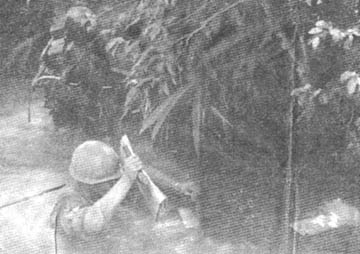 |
| HELP - CPT Henry Oakes, artillery liaison officer for the 1st Bn, 27th Inf “Wolfhounds,” chases his firing maps downstream during a search and des1roy operation along the rain-swollen banks of the Oriental River 26 Kms west of Cu Chi. |
Finger
Lickers
If the way to a man’s
heart is through his stomach, the 1st Bn, (Mech), 5th Inf, has given Viet Cong
in Hau Nghia Province a terrible case of heartburn.
In a recent raid on a giant
VC base camp 36 kms northwest of Saigon, the 25th Inf Div unit destroyed more
than 3000 sets of chopsticks and 400 sets of dishes.
The Viet Cong probably
won’t be coming back after the mechanized battalion destroyed their 84 large
living bunkers but “If they do,” said one company commander, “they’ll be
eating with their fingers.”
Page 4-5 TROPIC LIGHTNING NEWS Aug 7, 1967
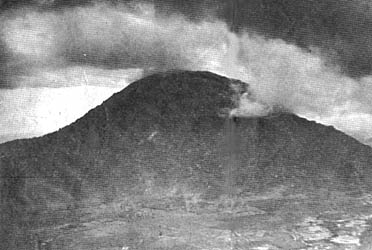 |
| The Legendary mountain of Nui Ba Den. (Photo by PFC Hairston) |
Atop
Foggy Nui Ba Den
By
1LT Larry Rottmann
An ancient volcano, the
massive fog-shrouded mountain of Nui Ba Den, juts abruptly from the flat
farmlands of Tay Ninh Province.
Vietnamese legend tells of a
woman, Ba Den, who centuries ago climbed the mountain grieving the loss of her
husband in war. She committed
suicide hoping that her proximity to the clouds would result in the act being
viewed directly by the Gods who would in turn unite her immediately with her
dead husband.
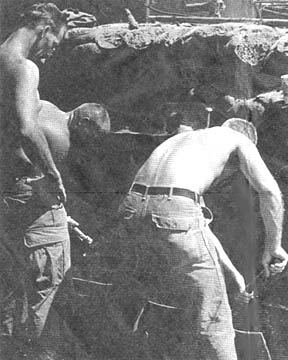 From its 3203 foot summit, all rivers and roads in the area can be seen.
For years the mountain has had great
significance. Its peak has
been occupied by the Japanese, the Viet Minh, the French and the Viet Cong.
It is currently the possession of the 5th Special Forces Group who
captured it in 1964.
From its 3203 foot summit, all rivers and roads in the area can be seen.
For years the mountain has had great
significance. Its peak has
been occupied by the Japanese, the Viet Minh, the French and the Viet Cong.
It is currently the possession of the 5th Special Forces Group who
captured it in 1964.
The tall mountain has proven
to be an extremely good reception point for radio and wireless communication,
and during the last year, communications teams from various Army units have set
up radio relay stations and re-transmission stations on the mountain top.
One of these units is the
125th Signal Det from the 25th Inf Div.
They moved to the mountain in March of 1967, and since that time have
begun to operate extensive VHF and FM radio facilities.
SGT Robert T. Hall of
Lester Pa., is the NCOIC for the seven-man detachment.
He is assisted by SGT. James Tapia of Yuma, Ariz.
At first the detachment had
only one radio and lived in a tent pitched on the rocky peak. But since March
they have acquired a whole bank of radios and corresponding electronic
equipment, and have also built themselves a small but adequate barracks.
The detachment is broken
down into two groups: the FM radio transmission team headed by Tapia, and the
VHF section led by Hall.
SP4 Nicholas P. Masciotti of
New York City, PFC George W. Lybarger of Buena Park, Calif., and PFC Robert H.
Shaner III of East Greenville, Pa., make up the VHF section. All these men are qualified radio operators and are trained
to perform minor radio repairs.
Their job is to operate and
maintain the 25th Inf Div VHF multi-channel equipment which relays transmissions
between Cu Chi and Tay Ninh, Dau Tieng and all units operating in War Zone
“C.” The VHF section also has
the responsibility of maintaining generators which supply electrical power for
their radios and billets.
The FM team, consisting of
PFC Randall C. Clark of St. Joseph, Mo., and PFC Eldon Walker of Houston, Tex.,
operates the FM re-transmission station located in a converted conex container.
They automatically relay FM radio communications for the 25th Inf Div,
25th Div Arty, 3/4 Cav, the 3rd Bde, 4th Inf, and 125th Signal Bn.
Since FM transmission is limited by the line of sight (usually 25 to 30
miles), the mountaintop location enables radio communication to be increased in
some cases up to 100 per cent.
All men in the 125th Signal
Det. work six hour shifts with the radios.
After that they are required to in an additional five hours on camp
detail (building bunkers, stringing barbed wire, making repairs, etc.) plus two
hours of guard duty every fourth night.
Living atop a mountain has
some unique problems, the biggest of which is resupply. According to 125th
Signal Bn. Commander LTC Louis G. Mithern Jr. of Toms River, N.J., all food and
supplies are flown in by helicopter. Delivery
is often delayed by the clouds and fog that blanket the peak.
Mail usually comes once a week.
Water has to be carried some
700 meters up the mountain by Vietnamese laborers.
It is used for washing, and after boiling, for cooking.
The men seldom drink it, for the VC use the same Spring.
The VC occupy the mountain
too, and often harass the camp with mortar and sniper fire. The 125th Sig. Det. is responsible for one 81mm mortar
emplacement and three machine guns. They
are trained to use them, and are frequently called on to do so.
 |
| Aerial view of Camp Nui Ba Den, showing bristling antennae atop old Buddhist Temple. Long building in foreground is mess hall and camp headquarters. (Photo by CPT B. R. Bland) |
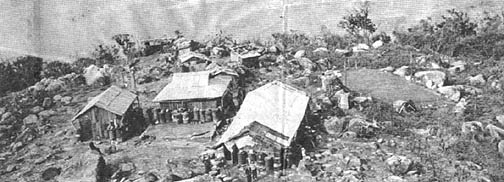 |
| View of the east end of the camp, showing CIDG quarters, Buddhist Shrine (center), and volleyball court. (Photo by LT Larry Rottmann) |
Page 6 TROPIC LIGHTNING NEWS Aug 7, 1967
7
Mile Move in 3 Hours
During the Korean War it
would have taken five days to move an artillery battery across the seven miles
of swamps and canals like those found west of the 25th Inf Div base camp.
Last week it took three hours.
Viet Cong activity in the
area made 2nd Bde Commander COL Edwin W. Emerson decide to move the 1st Bn (Mech),
5th Inf, far north in Hau Nghia Province. The
problem was that the Bde’s light artillery didn’t reach that far.
Only it wasn’t a problem.
Giant Chinook helicopters were called in and easily lifted the 105mm
howitzers of Charlie Btry, 1st Bn, 8th Arty, from their position at Hiep Hoa to
the mechanized base Foss to the north.
Ammunition and sighting
equipment were packed in special sling load containers beneath every howitzer so
that artillerymen could go to work the minute the gun touched down.
It takes a crack squad only
three minutes after the equipment is on the ground to have a round on the way to
greet “Victor Charlie.”
There are howitzers on the
ground ready to fire at all times, said artillery Battalion Commander, LTC Allen
M. Dean. “By the time the last
tube is ready for pickup at Hiep Hoa, there are three or four already set up at
Foss.”
Both units are taking part
in the 2nd Bde monsoon Operation “Kolekole” that covers Hau Nghia Province
from one end to the other.
 |
HELILIFT - A sling operator’s view of a howitzer being carried by a Chinook helicopter across the Vietnamese countryside. |
S&T
Supplies Troops
By PFC Gary
Gatliff
What’s for chow? This is a
question a guy would most likely be asking a buddy just returning from the mess
hall. But when that same question
is asked SP4 Moynahan, he might answer by saying, “Well we just got in 5500
pounds of hot dogs and 6500 pounds of steaks, so you can look forward to having
them in the next day or two.”
Moynahan and 47 other men of
Co A, 25th Supply and Transportation, work at the Class I Yard of the 25th
Inf. Div. Their job is to receive,
breakdown, store, and distribute enough food to feed hungry soldiers three good
meals a day. While it is no secret
that working men eat a lot, can you imagine putting away 33 tons of perishable
food, along with 678 gallons of ice cream four times a week?
The Class I Yard supplies
virtually all the edibles of the division with the exception of bread which
comes from the 1st Log Cmd bakery, under operational control of 25th S&T Bn.
The Class I Yard is divided into three main sections, the perishable
section, and the ice cream plant.
The ice cream plant seems to
attract touring VIPs. Secretary of
the Army Stanley R. Resor was said to have been very impressed when he toured
the facility.
As you can imagine, having
VIPs touring the plant regularly causes the men to try harder.
But, as LT Jon Rogers, OIC of the yard, explains it, “Oversights have a
strange way of making their appearance just when some important visitors arrive.
I’ll never forget the time we had a group of senior officers from the
1st Log Cmd come through. Everything
was fine till we passed out the ice cream samples. Then we found out there were no spoons to be had, they all
had to eat with folded ice cream cup lids and it got a little messy.”
The ice cream isn’t a
treat reserved for VIPs or just for men on the Cu Chi base camp. It is packed in special insulated containers and flown by
chopper directly to the front line soldiers.
Before the 25th Inf Div
arrived in Cu Chi, the base camp area was a peanut field.
Rogers commented, “We had an old French irrigation well where the
reefer (refrigerator) section is now. There
was a lot of work involved in getting that area properly drained.”
The reefers are kept stocked
by rolling refrigerator vans which make daily runs on the re-supply convoys to
and from Saigon.
The non-perishable items are
issued three times weekly to all units. If
the need arises the yard is always open and emergency issues can be made.
Stock rotation is also
practiced so the troops can have the freshest items, and to prevent excess
weathering of the containers. “There
are no warehouses to keep the non-perishables in,” commented Rogers, “and
even though the items are field packed, the intense heat and rain eventually
weakens the boxes and rusts the cans.”
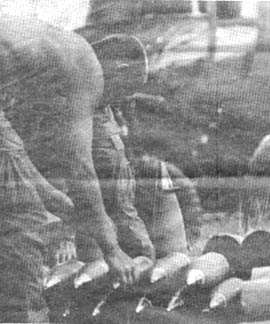 |
PREPARE - Artillerymen set up shell fuses as a Chinook sets down to unload more equipment in the background. |
Ham,
Lima Beans And Pepperoni
Americans have given their
support to the troops in Vietnam in many different ways but never before in
quite as novel a form as that received by the Medical Plt of the 1st Bn, 27th
Inf.
Letters received by men in
the platoon explained that the teachers and students of Meadow Moor Elementary
School in Salt Lake City, wanted to do more than just write to show their
support. Instead, they established
their own special project.
Starting with a collection
of $150, they bought and airmailed to the platoon pounds of pepperoni and beef
jerky.
The response from the men
was overwhelming. Many wrote to the
schoolchildren telling how good it was to munch the snacks while on operations.
“I can say this for sure,” said SP4 Patrick M. Mitchell of Bronx, New
York, “It sure was a welcome addition to ‘C’ rations.”
The program was so
successful that the school went further and placed advertisements in a Salt Lake
City paper asking for support. The
latest word is that another big batch is on the way, being forwarded by the
American Red Cross.
3000
Visits In 4 Weeks
CPT Murray “Doc”
Rothberg is still amazed when he looks back on the month of Medical Civic Action
Programs (MED CAPs) he’s just completed.
In four weeks the 1st Bn (Mech),
5th Inf, surgeon has treated more than 3000 Vietnamese patients in the 25th
Div’s area of responsibility.
“Sometimes while the
battalion was on the move we would go along from door to door conducting real
old-fashioned house calls,” says Rothberg.
Page 7 TROPIC LIGHTNING NEWS Aug 7, 1967
Cu
Chi Veterinarian Is Taxidermist
By PFC
Joe Carey
Would you feel comfortable
if the only doctor in town were also the local embalmer? Imagine how your pet would feel if he found out is doctor was
a taxidermist.
“If you like critters
there’s really not much to reconciling the two,” said CPT Thomas A. Dees, 25th
Inf Div veterinarian. “A
knowledge of taxidermy is just another aid in understanding animal anatomy,”
he added over a pinch of Copenhagen snuff neatly tucked between his lower lip
and gum.
After three years of
pre-veterinary training at the University of Florida, Dees decided he needed a
rest from academia and consequently spent a year working in a taxidermist’s
shop in Mobile, Ala. Though the
next four years were passed in veterinary school at Auburn University, he still
found time to work in the shop during the summers.
After graduating from Auburn
Dees returned to Edenton, N.C and began practicing with his father who is also a
veterinarian. A short nine months
later his local selective service representative informed him that his services
were required.
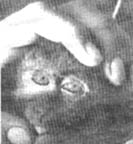 Having dutifully donned modern army green, he proceeded through a series
of courses designed to turn him into an Army veterinarian and food inspector.
He even found time for a mountain climbing course at Fort Bragg, N.C.
While at Bragg he also took care of a local “zoo” consisting of two
bobcats, three foxes, one coati mundi (according to Webster— a flesh eating
animal of Central and South America, similar to a raccoon), and two kinkajous
(also a flesh eating animal of Central and South America similar to a raccoon).
Having dutifully donned modern army green, he proceeded through a series
of courses designed to turn him into an Army veterinarian and food inspector.
He even found time for a mountain climbing course at Fort Bragg, N.C.
While at Bragg he also took care of a local “zoo” consisting of two
bobcats, three foxes, one coati mundi (according to Webster— a flesh eating
animal of Central and South America, similar to a raccoon), and two kinkajous
(also a flesh eating animal of Central and South America similar to a raccoon).
Working out of his office at
the 25th Div’s base camp at Cu Chi, Dees handles food inspection chores, keeps
scout dogs healthy, periodically checks pets and mascots, and is quite active in
civic affairs projects.
He is presently working with
CPT Edwin W. Richardson, civil affairs officer of the 4th Bn., 9th
Inf., on an idea for a rabbit farm in the village of Cau Phu.
He treated an injured water buffalo in the same village a short time ago.
He has made frequent trips
to the Dau Tieng area where he is trying to help the people provide more
sanitary quarters for their pigs. He
has found on his return to the village that the pigs have been evicted from
their tin-roofed, concrete-floored, septic-tanked pens and local citizens have
set up housekeeping in their stead.
His first encounter with a
government-appointed agricultural agent in Dau Tieng was not under ideal
conditions. There was no
interpreter available and the agent did not speak English.
A lieutenant on hand spoke French; the agent didn’t.
A villager spoke French and Vietnamese but no English.
Dees spoke to the lieutenant in English, who in turn spoke in French to
the citizen, who in turn spoke in Vietnamese to the agent, while Dees waited
patiently for the round trip to be completed.
 Since he has been in Vietnam Dees has treated bears, water buffaloes,
cows, monkeys, deer, a mouse deer, a goat, a bobcat, and set a broken leg on a
parrot.
Since he has been in Vietnam Dees has treated bears, water buffaloes,
cows, monkeys, deer, a mouse deer, a goat, a bobcat, and set a broken leg on a
parrot.
“There’s a great deal of
potential for a veterinarian in Vietnam,” says Dees, “but the three of us
are kept pretty busy. There just
doesn’t seem to be enough time.” The
three referred to are Dees and his two assistants, SP5 David L. Keigley of
Omaha, Neb., who handles much of the food inspection, and SP5 Frederick E.
Standard of Spokane, Wash, an animal technician.
Dees enjoys giving the
various division mascots an occasional checkup.
Recently, having had no success in coaxing a young goat to him with some
sugar cubes he had brought, Dees offered the kid a neighborly pinch of snuff.
Needless to say the offer was accepted and the two parted fast friends.
Dees would like to spend
more time out with the people, but he is responsible for veterinary work at
seven different posts. Even with
his five representatives, his official duties still take up most of his time.
He feels “the people are
going to have to get themselves established agriculturally before other
developments can take place. Sanitation
is the biggest problem. They just
don’t seem to understand that diseases are bred by fecal matter.”
Whether he’s stuffing
animals or stuffing pills into them, Dees always enjoys his work.
A good man to have around if you have a sick dog - or maybe a sick coati
mundi.
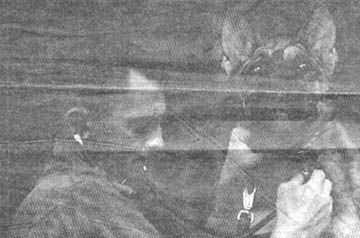 |
CPT Thomas A. Dees, 25th Inf. Div. Veterinarian, checks breathing on a member of the 38th Scout Dog Plt. |
Trip
Wire Doesn’t Trip
DUC
PHO -
SP4 Joe Ramos stepped on a trip wire attached to a five-inch naval round and 10
pounds of TNT and lived to tell about it.
“My foot had not quite
touched the ground when I noticed I had stepped on the wire, so I froze,”
Ramos related.
Alert squad members came to
his aid and an EOD team was called. The
team informed Ramos that if the wire had moved another sixteenth of an inch the
round would have exploded.
Ramos was with Co A, 1st Bn,
35th Inf, south of Doc Pho when the incident occurred.
Page 8 TROPIC LIGHTNING NEWS Aug 7, 1967
Jump
Team Looks For Trouble
 |
Assault helicopters maintain formation while awaiting assault orders. |
 |
The
team returns to choppers as grenade explodes. (left)
Swamp soldiers take off in pursuit of the enemy. (right) |
|
Destroys
VC Units
By 1LT A. R.
Karel
They travel fast and light
and they’re just looking for Viet Cong trouble.
That’s how the “Wolfhound” jump teams of the 25th Inf Div operate.
Orbiting over the combat
area in assault helicopters, the mission of the jump team is to provide a
lightning swift attack force to react immediately to any Viet Cong move.
A day in the life of a jump
team begins early when they scramble aboard their ships and climb to orbit
altitude. Alpha Co, 2nd Bn, 27th
Inf, did just that recently during a combat sweep by the battalion, as part of
Operation “Kolekole” northwest of Saigon.
Alpha circled for three
hours as the ground troops swept through hamlet after hamlet without contact.
Then the order was radioed
to Company Commander 1LT Mike Tarantola of Arlington, Va.: assault a suspected Viet Cong position just south of a vast
swamp. The ships dove for the
ground and the team jumped from the helicopter’s skids and was into a hedgerow
in seconds.
Gunships above spotted two
Viet Cong soldiers fleeing to the north as the team drove into the hamlet from
the south. Ground soldiers were
ordered to seal off escape routes to the east and west while the gunships swept
low on rocket and machinegun runs.
The jump team went right up
the center and followed the VC into the swamp.
Firing in water that was often shoulder deep, they killed one VC and the
gunships accounted for the second.
While ground soldiers moved
into the area to search for any possible remaining enemy troops, the jump team
sprinted back to their ships and spiraled back up to orbit altitude, ready for
another mission.
“The jump team combined
with the firepower of gunships is one of the most effective tactics we have for
destroying small VC units,” said Battalion Commander LTC Ed Peter.
“It’s something the Viet Cong in this area can expect to see a lot
more of in the future.”
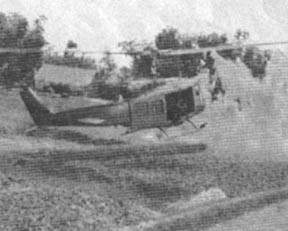 |
Chopper lands at smoke marked assault point. |
|
|
A team member searches a swamp for the enemy. |
 |
Thanks to
Lyle T. Shargent, 1st Bn., 35th Inf. 3rd Bde. for sharing this issue,
Kirk Ramsey, 2nd Bn., 14th Inf. for creating this page.
This page last modified 8-12-2004
©2004 25th Infantry Division Association. All rights reserved.